Pork Schnitzel (Vyprážaný Rezeň)
Although bryndzové halušky is officially the national dish of Slovakia, Wiener schnitzel (rezeň) is a strong contender for the crown. This fried cut of meat is really popular, and you will find it everywhere. It even appears between two slices of bread as a sandwich of sorts. In this recipe I show you how to make this extremely easy and tasty delicacy.
But first, what exactly is a schnitzel? This German word refers to a thin slice of meat (veal or pork), which has been tenderized by beating it with a mallet or a rolling pin. The resulting softened protein mass is called escalope or scallop. Tenderizing the meat improves its texture and also allows the meat to cook faster.
The word schnitzel is derived from schnitzen (to cut) or der Schnitz (a cut). This is similar to the Slovak name: rezeň is derived from rezať (to cut) or rez (a cut). A thin boneless slice of meat is the main ingredient in making this dish. The adjective vyprážaný simply means fried.
The Schnitzel is typically associated with Austrian cuisine (e.g. Wiener Schnitzel – Viennese Schnitzel). However, it is not completely clear where this dish originated. It is similar to the Italian cotolleta. Due to a very good reason, popularity of schnitzel exploded and it’s now prepared in some form all over Europe – and even the world. In fact, the American chicken fried steak is a variant of rezeň. The main difference between the two recipes is that in Slovakia and the Czech Republic, rezeň is made with pork. In the United States, it is beef.
But enough said, let’s roll up those sleeves and start cooking!
Ingredients: boneless pork cutlets, flour, eggs, bread crumbs, oil for frying, side dish
Prep Time: 30 minutes
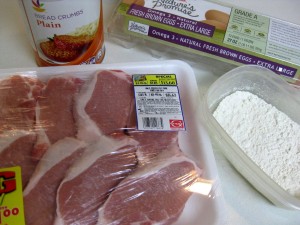
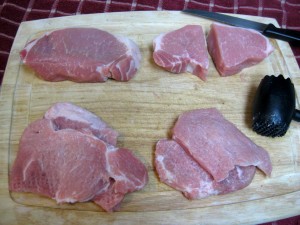
Go to your local grocery store and grab some boneless pork cutlets. The thinner the better. I had to make do with these thick ones since that’s all my grocery store had in stock. Using a tenderizing mallet, beat the meat until it is about quarter inch thick. I was preparing these rezne for a potluck at a friend’s church, so I made them small, appetizer sized. Each pork chop turned into four pieces.
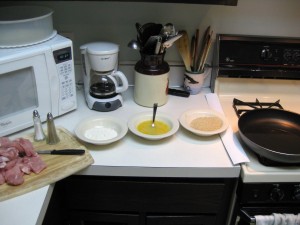
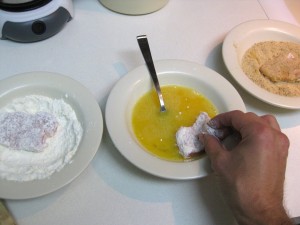
Season them with salt and pepper. Then set up your breading station, just like when frying cheese. Cover them in flour, beaten egg and plain bread crumbs.
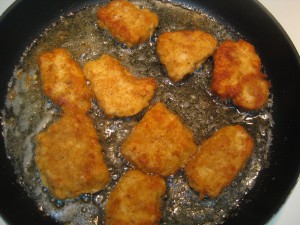
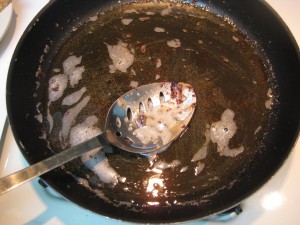
Then place them into a frying pan containing a lot of hot oil. Fry on both sides for few minutes until they get golden brown. In between batches, remove the pieces of batter that stay behind. These can turn black and get stuck to other steaks. Not only is this not very aesthetic, there is also some evidence these burned pieces may lead to diseases. But most importantly, these contaminants reduce the smoke point of oil, causing it put off the obnoxious (and smoke-alarm triggering) smoke at temperatures required for frying. You need the oil to be above 300F, in order to trigger the Maillard reaction. This reaction is what turns the bread crumbs crunchy, and induces the delicious flavors found in fried foods. (This tidbit is brought to you by On Food and Cooking, which is an AMAZING book!)
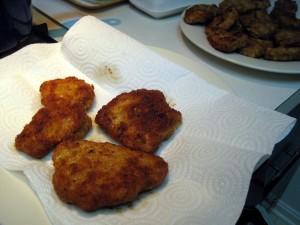
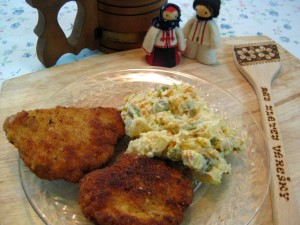
Scoop out the fried pork cuts onto a plate covered with paper towels. Pat dry to remove excess oil. Serve with mashed potatoes or potato salad. Dobrú chuť!
By the way, this is not the only way to fry a schnitzel. There are many variations on this basic recipe. The meat can be topped with ham, cheese, or even bacon (which is known in Slovakia as Shepherd’s steak). The meat can be breaded in dough or even potato pancakes). Instead of steak, you can fry hamburger meat. And you can fry many other things besides meat. Fried cheese and fried cauliflower are two extremely popular “vegetarian” dishes.
One of my favorites!!!!!!
yes, in my young years that’s how I knew it’s Sunday. We might have a schnitzel for Sunday dinner 🙂
I do both, veal and pork schnitzel, veal may be a bit finer in texture but both of them are great. I go by “Vienna school” and I add a bit of parmesan cheese to flour and sprinkle schnitzels with lemon juice before serving.
Potato salad was a preferred side dish, but any potatoes (boiled new potatoes or mashed potatoes) are good.
Yum! Delicious! I love Slovak food!
I remember my mother making these more than a half-century ago, but she used slices of pork tenderloin which produces a lovely, round shape before pounding, breading, and frying.
HI, MY GRANDMOTHER USED TO MAKE THIS ALSO WITH PORK TENDERLOIN AND IT WAS VERY GOOD! NOW I WANT SOME!
I made this for my Slovak host students after one mentioned missing it. I also made the potato salad with it. They were very pleased, and so was I!
my grandmother made this with boneless chicken thighs pound flat oh so good i guess they used whatever was there in the market, could’t afford veal
You should try it as a sandwich, it’s delicious!
Tasty dish.
I ate at a family in the Carpathian Mountains.
On the territory of Ukraine.
A similar kitchen.
Thank you
My Slovak wife’s Slovak cousin says the best bread crumbs are made from three day old Slovak bread.
My wife says it’s also called snicla (with a makcen) over the s)–a standard for lunch on Sunday.
Hi, just wanted to comment on what your wife calls the snichtzel, snitchla in Slovak! My Mom and Grandma called it the same. So delicious and was always excited to smell the auroma of the snitchla cooking as we came home from school! I make it now for my family and of course they all love it!
Schnitzel indeed is not made from pork, and never from hamburger meat, but from veal or some light meat as turkey or chicken. I am from Slovakia, it is never done as described…
This is exactly how my grandmother made it and she came from Slovakia.
love German food just wish there were more